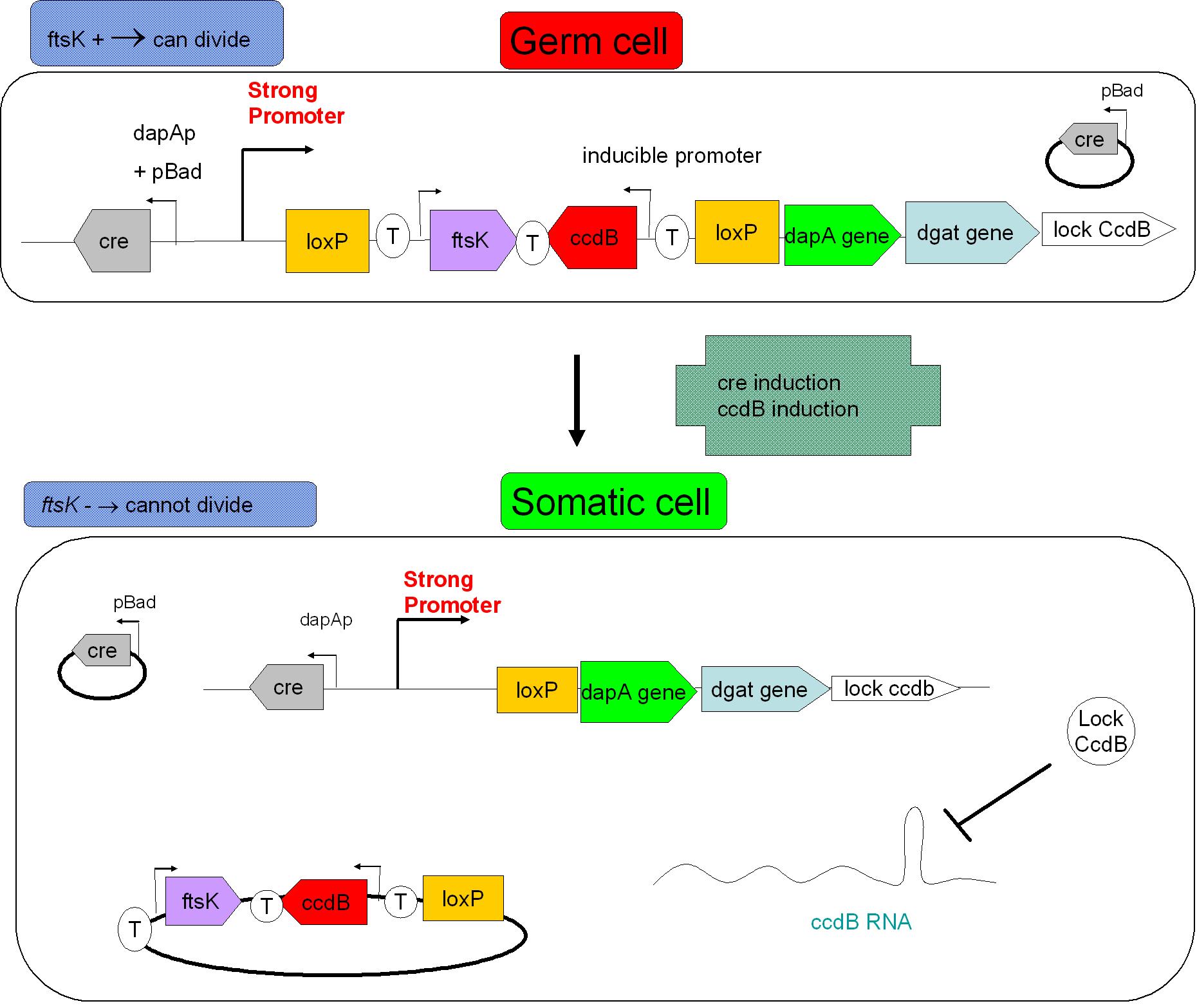Paris/Perspectives
From 2007.igem.org
SMB is composed of a germline and a soma. Germ cells are responsible for reproduction while the sterile somatic cells, are essential for the germline as the soma exports the DAP compound, supporting germline growth. The special feature of our system, the coexistence of two independent cell types, one dedicated to reproduction and the other sterile, makes it a potentially interesting tool for synthetic biology.
The SMB could also be used to explore basic questions in fundamental biology. If submitted to long time growth, in a chemostat for instance, the SMB could become a model to study how the genome of a cell can evolve leading to changes that do not directly affect the cells phenotype. This system could mimic evolutionary phenomena that are typicall of multicellular organisms.
Contents |
System improvement through directed evolution
The engineered MSB may be further tuned by laboratory evolution. A key advantage of the system is that selection pressure could be tuned to either force faster reproduction (e.g., improving DAP production and/or export from the soma or alternatively for a more efficient use of DAP within the germline) or for improvement of soma-specific functions (see below). In other words, the soma-germline MSB dichotomy provides us with the possibility to select for functions that are otherwise deleterious for the unicellular organism.
Applications
We envision two immediate applications to the Synthetic Multicellular Bacterium. It could be used as a “metabolic plant” or as “security device”
Decoupling reproduction faculty and transgene expression
In the SMB system, any given gene or gene circuit can be selectively expressed in germ cells or somatic cells. Knowing the soma is unreplicative, we are disrupting the connection between the reproduction of the system and the expression of the transgene, leading to potentially interesting applications.
We would like to develop two extensions to the SMB : metabolic engineering and secured genetically modified organisms for environmental release.
Security device
We came up with the idea of modifying the synthetic organism in order to allow, on demand, the full differentiation of the germline into soma in a secured fashion. Why would we want to do that? This possibility is to be considered in the face of biohazard risks. Release of GM organisms in the environment poses ethical as well as technical questions. “Biological security” should be a prime concern in synthetic biology.
If a task is to be transiently performed by a GM organism in the open environment, a major problem is persistence of the GM organism, with potential risks of proliferation and transgene dissemination. A possible solution, already used for some GM crops, is to render the organisms sterile. Can this solution be implemented for GM bacteria, in bioremediation systems for instance? Using a modified version of our SMB, the answer is yes. The SMB comprises two cell types, one being the soma, a group of cells that have a longer lifetime than wild type E.coli cells & are unable to replicate. The soma cells have the required characteristics for transient use in open environment.
The next consideration is then: can full differentiation be induced in the SMB? In order to achieve this, two events should be initiated:
- Induction of a massive differentiation of the germ line into soma cell
- Followed by selective death of the persistent germ line cells.
For details on proposed technical solutions to this challenge, SEE HERE
Metabolic engineering
A bacterial multicellular organism could allow optimizing the production of compounds deleterious to the cell. If one attempts to optimize the production of such a compound in a classical bacteria (E.coli for instance), trade-off appears between the production of your compound and the growth of the cell. The synthetic multicellular organism could in part bypass this problem by partially decoupling growth from synthesis of the exogenous compound. It could indeed be modified so that only the soma produces the noxious molecule. If a mean exists to screen for maximum production of this molecule, you could then select the germline whose soma would have the best exocompound production yield. As long as the production doesn't impair too much the capacity of the soma to feed the germline, the optimization can go on. Thus, a trade-off also exists in this case, but it would very well less stringent that in the wild type E.coli case.
Of course, all this is only possible if the germ line is not affected by the products released by the soma. Compounds that could be optimized in this way are thus constrained to molecules that can be noxious if accumulated in the cell, but that do not affect it too much if in the medium. For instance, if the product can be gradually filtered out of the medium.
E. Colight: towards a new slim diet
Project
In an attempt to integrate all the proposed applications of the SMB, we advanced towards the construction of Ecolight. Bringing together the synthetic organism (SMB), noxious compound synthesis ("metabolic plant"), and the security device. This would include optimizing the production of triglycerides in the soma cells of our synthetic multicellular bacterium. Soma isolation according to the "security device" would be included. The super triglycerides-producing-not-able-to-divide soma cells could then be ingested. The fatty acids they would store would be as many fatty acids you will not absorb! Eat fat, don't get fat!
E.colight project is also made up with 2 independent parts. First we have to create the SMB to implement the secured module. Second E.coli has to absorb free fatty acid and to synthesize triglycerides in the cytoplasm.
References:
- 2006 Physicians' Desk Reference (PDR). Thomson PDR
- BBa_I718002

